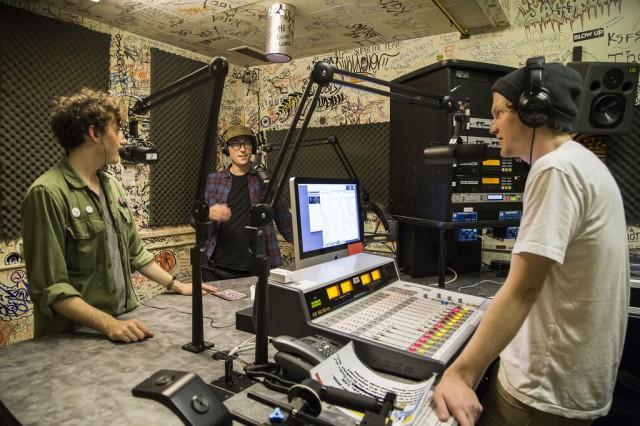
Written by Ben Tasner Photos by Lorisa Salvatin
Students rest their arms and legs as they lie on the floor of a darkened dance studio. The room is an ocean, and their bodies, like softly breaking waves, unfurl in the moonlight of the half-cracked door. The instructor, like a captain speaking to the ocean, encourages her students to relax.
Vivian Chavez, a professor of health education at SF State, leads her students through relaxation exercises intended to improve body and breath awareness. Lying on the floor, students place their hands on their collarbone, chest, diaphragm, and lower abdomen to observe their bodies as they breathe.
Practicing breath awareness is one of many ways that students can easily maintain and improve their own health. The life of a college student is stressful, which makes simple self-care health techniques invaluable when time and resources are limited.
Many college students are leaving their families for the first time to enter an environment filled with academic and social pressures. Most students juggle jobs, classes, and relationships while battling exams, aspiring for good grades, and holding on to hope that career opportunities await them.
A 2010 study of two-hundred-thousand full-time college freshmen at four-year universities, conducted by the Higher Education Research Institute at UCLA found that the emotional health of college freshmen has dropped to the lowest level in twenty-five years.
“Students are stressed because they have so many thoughts,” says Jun Wang, professor of holistic health studies at SF State. “They have fears about the future, interpersonal relationships, graduation, and lack of time. When you feel like you need to do things in a compressed amount of time and when you don’t enjoy what you’re doing, you get stressed.”
Over-stressed students are likely to experience depression, anxiety, various physical ailments and a myriad of other health problems. Sometimes it seems best to turn to a medical authority for help and medication, but what if you could improve your health and decrease your stress on your own? Wang says it only takes five or ten minutes to recover from the stress of the day.
But it is. Many simple self-care practices exist with roots in ancient eastern and western practices that have proven beneficial for thousands of years. All of the methods focus on body, mind, and awareness of breath. Some may emphasize one aspect more than another, but to truly increase health and decrease stress it is essential to integrate all three. Too often do we turn to a doctor for a pill or hop on the treadmill- eyes glued to the television, ignoring the connection between body, mind, and breath. Take ten minutes to try one of the holistic self-care practices outlined below and see if you notice a difference in your health.
Body: Many physical (somatic) practices are available for students to quickly relax their bodies. Physical relaxation is the first step and perhaps the most direct way to quickly decrease stress.
Wang, who teaches Chinese perspectives in holistic health, Chinese herbs and nutrition, and Chinese body-mind energetics, focuses on the development of qi (pronounced ‘chi’) as a tool to improve and maintain health. Qi can be translated as ‘vital energy’, similar to prana and cit in Hindu religion, mana in Hawaiian culture, lung in Tibetan Buddhism, and ruah in Hebrew culture. Or if you subscribe to the Star Wars philosophy it is like “The Force.”
“If you have strong qi you have a strong defensive system,” says Wang. “You can still be balanced while enduring physical or emotional stress.”
To cultivate qi you need to start by relaxing the body.
“Our mind is like water in a cup,” says Wang, analogizing the human body with a cup. “First you need to stabilize the cup.”
The effects of student life lead to an irregular lifestyle. Many students do not eat properly or sleep adequately and these habits lead to stress, which often manifests physically. Relaxation is a quick and easy way to combat the toll that stress takes on the body.
People commonly stand, sit, and even fall asleep with their shoulders
elevated. It is known as the red light reflex, or startle response, which
many people live with unknowingly. In this condition, a person’s body is hunched, their shoulders are elevated and muscles tensed in response to anxiety and fear.
Erik Peper, a professor of holistic health and director of the Institute for Holistic Health Studies at SF State, attributes this condition to an adaptation made when humans once lived in physical danger and protecting the neck was vital. But in today’s society, danger rarely presents itself in the same manner and the red light reflex has become a liability.
Progressive Relaxation is an easy self-care practice to decrease muscle tension and increase body awareness, hopefully reducing habits like the red light reflex that lead to body stress.
Start by focusing your attention on the muscles in your toes. Tense them vigorously for a few seconds and then release. You should notice a greater level of relaxation in your toes. Slowly work your way up your body, tensing each muscle group individually: your calves, quads, gluteus, abdomen, hands, forearms, upper arms, shoulders, and even all the muscles in your face. Make sure to breathe regularly throughout the exercise.
This exercise draws on what Richard Harvey, a professor of health education at SF State, calls the principle of opposites. He says that you have to first experience the extreme end of an issue to gain perspective on a healthy baseline.
Yoga is a physically focused practice (with mind and and breath components) that many people employ to increase health. With its origins in ancient Indian philosophy, yoga is a mind-body practice that incorporates breathing techniques. The number of Americans practicing yoga increased thirty percent between 2008 and 2012, with more than twenty million Americans currently practicing according to a study by Yoga Journal.
“Yoga is important because it stretches the tendons,” says Wang. “This allows your qi to flow more smoothly.”
Robert Gonzalez, a health education major, says yoga centers him.
“Yoga practice helps with stress, so I do not feel as nervous or stressed as before.”
Tai chi and Qi Gong are two more practices that can increase energy and decrease stress. Tai chi, which began in China as a martial art, is commonly used for health benefits. Qi gong is less aerobic than tai chi, but both exercises involve deliberate movements of the body to stimulate qi. They help develop concentration, presence, and balance yin and yang energies. In Chinese medicine, all illness, whether it is physical or emotional, is attributed to an imbalance of yin and yang energies.
Yin can be equated to the physical nature of existence, and yang the transformative. On a grand scale, earth is the yin and the sun is the yang. Food (yin) becomes energy (yang). According to Chinese medicine, everything we experience is due to an interaction between yin and yang.
By developing qi and balancing yin and yang, tai chi and qi gong are two physical exercises that relax the body and quiet the mind.
“It is very important for you to relax your body,” says Wang. “When your posture is correct then you can relax your mind and cultivate qi.”
It is important to foster physical relaxation, especially for students who spend countless hours sitting in class and in front of computers. Even if you do not embrace any of the practices mentioned above, you should apply some sort of physical practice to your daily routine.
Stretching and massage are other useful tools to relax the body. The holistic health network on campus hosts a massage hour that meets regularly each week. Led by certified massage therapists, students give ten to twenty minute massages free of charge to anyone that stops by.
Mind: Many of the mentally focused practices that students can adopt to improve health and decrease stress revolve around various forms of meditation. Meditation is a modest practice that can be accomplished sitting, lying, standing, or walking. A student does not need to become an expert in meditation to experience the benefits. By simply practicing meditation, a person is accomplishing the task.
Meditation can be a closed-focused experience, like focusing on the flame of a candle, or more open-focused, like observing thoughts and judgments.
Meditation techniques like mantra meditation, mindfulness meditation, Zen Buddhist meditation, and others derived from religions and spiritual practices. Many people use them today to increase health without religious association.
Previous research has found that meditation can reduce depression, anxiety, and chronic pain. More recently, a 2011 study published in the journal Psychiatry Research: Neuroimaging, found that meditation also increases gray matter concentration in the left hippocampus of the brain. The left hippocampus is involved in learning, memory, and emotional control.
Chris Hambelton, a holistic health student at SF State, says that mindfulness meditation has helped him observe when his mind is judging.
“I notice when my thoughts are beating on me for no reason,” he says. “(Meditation) helps you learn to be a better friend for yourself.”
He’s referring to the all-too-common act of self-judgment. Too often people degrade themselves with judgments they would never cast on another person, and the negative self-talk has serious health repercussions. Dwelling on past mistakes and fearing the future is unhealthy. Depression is a result of focus on the past, and anxiety is a focus on the future. Meditation helps draw the practitioner back to the moment. Learning to observe the present and decrease thoughts about the past or future has enormous health benefits.
Wang says she experiences stress just like her students. She practices meditation every morning and experiences wonderful benefits. It helps her still her thoughts.
“I can maintain a calm way to deal with an insane world,” she says.
Components of meditation include imagery and visualization. By imagining what you want and visualizing it as a reality you will increase optimism and experience a direct physiological benefit.
Imagery and visualization can be practiced as part of meditation, or as individual exercises. Many professional and Olympic athletes use visualization prior to performance to increase results. Researcher Angie LeVan says that the brain acts similarly during visualization as it does during the actual physical act, which means that the brain is training during visualization.
Breath
Perhaps most integral in self-care is breath because it is a doorway between the conscious and the unconscious. Breath is something we can intentionally control and it is also a natural which cause a person to hold their breath unconsciously. Shallow breathing limits the body’s ability to carry oxygen to cells, and in turn can make a person feel short of breath and anxious.
When a child is acting out of control they are told to count to ten, a strategy that draws on the principles of deep breathing.
“When you count to ten, usually by five, your mind and reactivity has changed due to awareness of breath,” says Chavez.
Sabreen Khalil, a psychology major at SF State, uses breathing techniques before an exam. “It helps me bring my stress level down so that I can focus on my test because it really cools your body down and brings you back to the present.”
Whitley Lucas, a health education major at SF State, has applied deep breathing to her daily routine. “To actually breathe and relax your mind is so powerful because it can help reduce stress that may be bothering you,” says Lucas. “In my down time during the day I do stretches and breathing techniques to get my mind and body together.”
In addition to his research on the red light reflex, Peper is interested in the physiology of breathing. In his book “Make Health Happen,” he wrote that extended computer use and long hours of poor posture exacerbate poor breathing habits. He helps students train their bodies to relax so that they can perform better on exams.
He says that people who habitually engage in shallow chest breathing may experience panic and symptoms associated with hyperventilation. He recommends students to breathe with their diaphragm to decrease tension, increase oxygen flow, and improve their test scores.
To test your breathing habits, start by placing a hand on your chest and your abdomen. Peper says that a deep breath should begin with a full expansion of the diaphragm, followed by expansion of the lungs and chest. Peper and Chavez encourage students to practice deep breathing by finding a quiet place and counting each breath. Chavez says that counting brings awareness to breath and limits distracting thoughts.
When she has trouble sleeping, Chavez counts her breaths up to ten and then back down. She is usually asleep before she gets back to one.
In the darkened dance studio she wants students to take what they need from the breathing exercise. Occasionally someone falls asleep during the practice, which is fine with her.
“Every direction that I give you is an invitation only,” says Chavez quietly, embracing the darkness. “If you want to do something different, do it. This is your class.”
Sometimes what is needed most is sleep. It is a perfect combination of body, mind and breath relaxation.
Note: Many other self-care practices exist that can quickly increase a student’s health. Stop by the Holistic Health Learning Center, in HHS 329, and check out the unique library of resources.






synchronized wireless clocks • Jun 10, 2015 at 4:13 pm
click here for the greatest multiple time sync anywhere